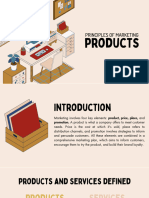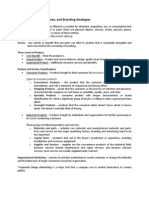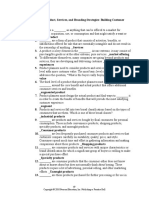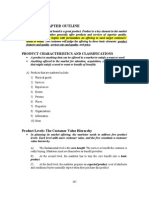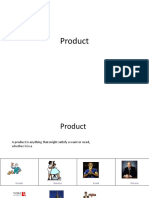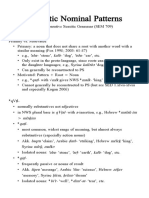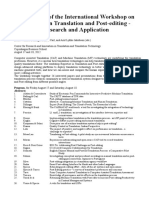Chapter 3
1. **Product:** A product is broadly de ned to include goods, services, and ideas. It serves
consumers, is subject to communication between consumers and producers, and can have
an image similar to brands.
2. **Market Segmentation:** The process of dividing the market into distinct groups based
on certain criteria, such as demographics, psychographics, or geography.
3. **Product Di erentiation:** Making a product distinct in the eyes of consumers, often
through changes in physical appearance, advertising claims, or unique features, to compete
e ectively in a saturated market.
4. **Product Life Cycle:** The theory that a product goes through stages—introduction,
growth, maturity, and decline—each with implications for marketing strategies.
5. **Line Extension:** Adding new products to an existing line to increase variety and sales,
which may involve market segmentation.
6. **Product Analysis:** Involves collecting and analyzing relevant data about a product,
including features, uses, quality, distribution, packaging, brand image, and price.
7. **Positioning:** Traditionally de ned as the product's bene t claim, but in a more modern
sense, it is the product's place in consumers' minds achieved through advertising.
8. **Product Concept:** The principal value of the product for consumers, forming the core
idea in advertising and merchandising strategies.
Questions :
1. A service can be considered a product when it serves consumers and is advertised. For
example, advertising for a cleaning service or online streaming platform. An idea becomes a
product when it is communicated and promoted, like public service announcements.
2. A retail store is considered a product due to its image, service, and identity. Yes, people
often use speci c stores regularly based on factors like location, convenience, quality, and
atmosphere.
3. Along with an identi able product, a person "buys" the service and warranty that
accompany it, along with their expectations of product performance.
4. The strategy of concentration directs marketing toward a speci c subgroup, while
di erentiation identi es and targets two or more subgroups.
5. Examples of di erentiation include changing a product's appearance or making unique
advertising claims, such as adding a new scent to a dishwashing liquid.
6. The strategy of di erentiation focuses on the overall market, while product di erentiation
emphasizes making a product unique in the consumer's mind.
7. Product di erentiation is important to stand out in a competitive market. Ways to
accomplish it include visible product changes, unique advertising claims, and creating a
distinct brand image. In your country, examples might include new features in smartphones
or unique avors of snacks.
8. Consumers need to perceive a product di erence as a bene t. Signaling product
di erence can involve changes in the company's image, store atmosphere, brand, price,
package, or advertising.
Pied de page 1
ff
ff
ff
fl
ff
ff
fi
ff
fi
ff
fi
fi
fi
ff
fi
fi
fi
ff
� 9. Product di erentiation can extend the product life cycle by making a product stand out
and remain appealing to consumers throughout its stages.
10. Besides a completely new product, an addition to a product line goes through an
introductory stage.
11. In the introductory phase, growth is slow, prices are high, and advertising expenses are
high relative to sales.
12. During the growth period, sales rise quickly, with increased competition, improvements
in the product, and higher advertising expenses.
13. In the maturity stage, growth slows, prices and pro ts decrease, and any sales growth
comes from population growth or at the expense of competitors.
14. The decline period is recognized when new products replace old ones, and it a ects an
industry by causing sales to drop, leading manufacturers to abandon it.
15. Line extension increases the life of a product by adding new products to an existing
line, increasing variety, and, in some cases, involving market segmentation.
16. Examples of line extension involving market segmentation: a bedding manufacturer
adding linens for children. Examples without segmentation: Jello adding a new avor.
17. Besides di erentiation and line extension, the product life cycle can be extended by
nding new uses for old products and adding servicing.
18. Correct order: Pioneering advertising - Introductory stage, Competitive advertising -
Growth and early maturity, Retentive advertising - Maturity stage.
19. Brand awareness matches with pioneering advertising, brand preference with
competitive advertising, and brand loyalty with retentive advertising.
20. An advertiser should know about a product's uses, functions, quality, construction,
distribution patterns, packaging, brand image, and price.
21. The two major considerations in product analysis are how the product compares to
competition and how it is positioned in consumers' minds.
22. List of ve familiar products: smartphones, laundry detergent, running shoes, laptops,
and bottled water. Features and bene ts vary based on the product.
23. Recent unique products: electric scooters, plant-based meat substitutes, smart home
devices, virtual reality headsets, and foldable smartphones.
24. Familiar brands: Coca-Cola, Nike, Apple, Amazon, Samsung, Toyota, McDonald's,
Google, Adidas, and Pepsi. Discuss how each is positioned in a classmate's mind based on
perceptions.
25. Examples of successful repositioning: Arm and Hammer baking soda being advertised
as a deodorizer, expanding its use beyond cooking and soothing upset stomachs.
By Hanan Anflous
Pied de page 2
fi
fi
ff
ff
fi
fi
fl
ff


